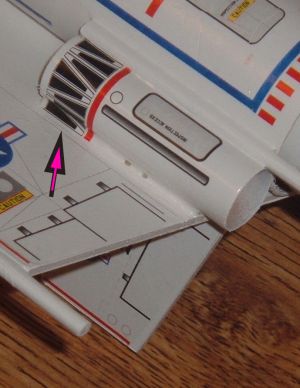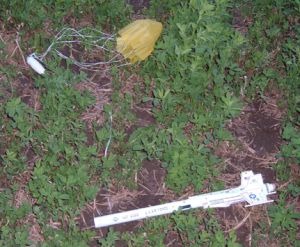| Construction Rating: | starstarstarstarstar_border |
| Flight Rating: | starstarstarstarstar_border |
| Overall Rating: | starstarstarstarstar_border |
| Manufacturer: | Sirius Rocketry  |
Brief:
I had seen Sirius Rocketry's "U.S.S. Atlantis Refit" online and was
pretty intimidated by its apparent complexity. However, when I saw the Atlantis
in person at NARCON 2006, it was smaller than I expected it to be. What
really caught my eye was a new kit that David J. Miller had on display
at his booth. Unfortunately, he said his Interrogator wouldn't be available for
another month or two, so I kicked my toe in some imaginary dirt and wandered
off.

Two months later, I emailed Dave, still sniffling that he didn't have any Interrogators ready for release yet. He finally broke down and sent me an 18mm version under the condition that I'd have to do a little public relations work for him in return. Stay tuned! The publicity barrage begins now.
Construction:
The kit includes:
- BT-50 Main Body Tube, 17" Long
- BT-55 Intake Tube, 7.3" Long
- 2 BT-5 Ramjet Tubes, 1.75" Long
- BT-20 Motor Mount Tube, 2.75" Long
- 2 CR-2050 Centering Rings
- Engine Hook, 2.75" Long
- PNC-50KA Plastic Nose Cone
- 1/8" dia. Launch Lug, 1.25" Long
- 1/16" Thick Balsa Sheet, 3" Wide x 12" Long
- PRM (Paper Reinforcing Material) Blank Sheet
- PRM Fin Pattern Sheet
- Traditional Cardstock Fin Pattern Sheet
- Intake Tube Cutting and Marking Guide
- 24" Kevlar® Shock Cord Mount Cord
- 1/8" Wide Elastic Shock Cord, 36" Long
- 12" Mylar Parachute Kit
- 1/8" Diameter Dowel, 7.3" Long
- 4 1/8" Diameter Dowels, 2.75" Long
- Waterslide Decal Sheets #1-3
The Sirius Rocketry Interrogator is rated a Skill Level 3 out of a possible 5.
One glance at the 12-page assembly manual made it obvious that David has built plenty of model rockets. The black and white photos were obviously easier to produce than line drawings but still clearly illustrate the necessary steps. Chances are good you've never built a rocket with all of these particular methods so pre-reading the instructions (no matter how superficially familiar they might seem) is an absolute must. If you don't, you're bound to hit a least a couple of "gotchas."
Dave unloads some excellent building tips in the first page and a half of the instructions. Unfortunately, since he needed me to finish this project quickly, I didn't take any "extra" steps, like filling the body tube spirals. I used yellow glue throughout the whole build.
The body tubes are standard Euclid white tubes. The tube ends weren't cut quite precisely but 220 and 320 grit sandpaper soon rectified that. (This actually added to the need for "craftsmanship" on my part and the enjoyment of the build as far as I was concerned.) I used 220 grit sandpaper to knock the glassine finish off of the tubes. The BT-55 was the only tube with noticeable spirals. There was no thrust ring (engine block), so I added one for good measure.
I had to peel an inner layer from the CR-2050 centering rings before they'd slip fit over the BT-20 motor mount tube. Kudos for Step 8! The accompanying photo in the instructions shows exactly how to decide how long your Kevlar® thread should be. In the "Before You Begin" (BYB) section of the instructions, Dave reveals his deep, dark trade secret that "In each Sirius Rocketry kit, we try to introduce, or re-introduce, different building methods and materials to add to the modeler's experience." I don't recall ever actually cutting a body tube on an angle, but the enclosed marking and cutting guide (and Dave's encouraging instructions) made it fairly easy. That, and some 100, 220, and 320 grit sandpaper!
This rocket went together a lot more quickly than I thought it would thanks to covering the fins with paper and the plastic nose cone. As a Born Again Rocketeer (BAR), I've gotten used to having fill and sand countless times before completing a rocket so building the Sirius "Interrogator" was a nice change of pace. The unusual fin finishing technique consists of peeling and sticking two pieces of computer label paper (one of them with the fin patterns thoughtfully pre-printed on it) to opposite sides of the 1/16" balsa sheet. Don't glue it on like I did the first time! The edges of the fins are sealed with thin CA. If you have some excess CA run onto the rest of the fins, gentle sanding with 400 grit sandpaper should knock off both the roughness and the shine.
The BYB instructions say, "Don't worry about the fin stock grain direction in this case. The laminated fins are quite strong in all grain directions when done properly." However, Dave's kind (serious?) enough to include "old school" fin patterns and enough balsa for the traditionalists among us to "do their own thing." In fact, I was so excited with being able to skip the fin filling step that I applied it to other models I was working on. I've also started taping body tubes down to my work surface to make sure they don't roll while fins are drying. The new techniques alone are worth the price of this kit!

Finishing:
Only apply fillets where they're spelled out in the instructions! I got a
little exuberant and ended up kicking myself when I filleted the ramjet tubes
to the wings and screwed up the waterslide decal application there.
I applied one coat of primer and two coats of Krylon Gloss White, then went to work on the decals, which are practically Shroxian (!) in their quantity and detail--the equivalent of an entire 8.5" by 11" sheet.
I told my wife that the Sirius Interrogator had enough decals for four rockets! You'll need to polish up on your decals application skills if they're rusty. I managed to trash the two bands that go around the main body tube and the big decal on the underside of the BT-55 intake tube was a bear to wrestle on without tearing it. I cut apart the two sections for the upper side of the gussets and the main wings (between the rudders) to make putting them on easier. However, I soon got the hang of things and when I showed the finished product to my wife, the only word that came out of her mouth was, "Beautiful!"
I clearcoated the whole rocket with Premium Decor Clear Acrylic (as recommended by Tom Prestia of Tango Papa Decals) and didn't have any kind of crackling at all.
Some of the influences of this design are identifiable, while other elements are more subtle. The Interrogator name font is nearly identical to Star Trek (the original series) typeface. The intake tube reminded me of Centuri's Super-Kit SSV Scorpion and the rudder and wing decals are vaguely reminiscent of the Estes Interceptor.
Construction Rating: 4 out of 5
Flight:
I prepped the rocket with four sheets of Estes wadding and I substituted a
12" rip stop nylon chute for the enclosed Mylar parachute. (I wasn't sure
how beefy the Mylar chute was, but Dave's methods of reinforcing the attachment
points seem to work nicely. However, it remains to be seen how the parachute
will hold up on repeated flights.) The lengthy main body tube provides plenty
of room to pack the recovery system.
I used an A8-3 for the Interrogator's first flight, which had me holding my breath for most of the trajectory. This high drag rocket design only made it about 100 feet in the air, and the ejection charge fired well past apogee. Fortunately, the recovery system deployed in enough time to prevent a less than gentle encounter with the ground.
The following two B6-4 flights were much more satisfying with the Interrogator roaring to about 250 feet. I'd left my C6-5 motors at home since the wind had been gusting up to 30 miles per hour earlier in the day. However, I think this rocket would turn in a fairly visible flight profile even on a C.
I'd recommend not even using an A8-3 motor on this model, and sticking with B6-4's for small field flying, although you could probably get away with a C6-5 on medium-small flight ranges.

Recovery:
I used the Mylar parachute for the third flight, which took up more room in the
main body tube than the nylon rip stop chute and seemed to "snap"
louder when it opened.
Flight Rating: 4 out of 5
Summary:
PROs: It looks stinkin' cool. (What, you need more?) The instructions are
written clearly, packed with plenty of handy tips, and have Dave's enthusiasm
and sense of humor coming through in just the right amounts. The waterslide
decals were incredible in their detail. (Did I say this rocket looks cool?)
CONs: No engine block (thrust ring) included and the mylar parachute made me nervous (even though the silver was cool). It's too heavy for comfortable flights on A engines. Oh, and now I'll be jonesing until Dave comes out with something even cooler (but hopefully still affordable).
Overall Rating: 4 out of 5
 |
 |
Flights
Sponsored Ads
 |
 |











